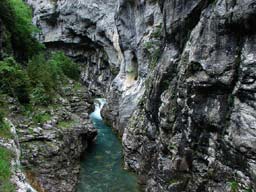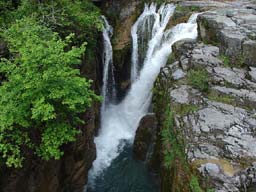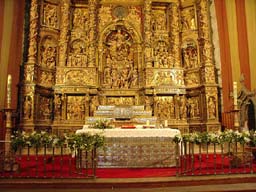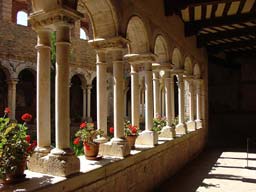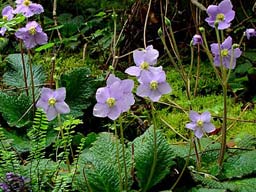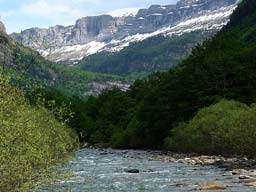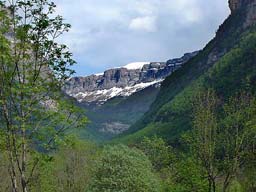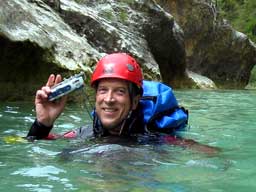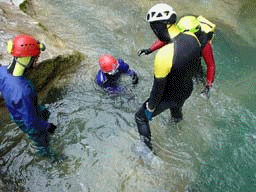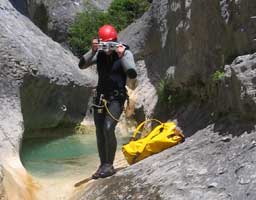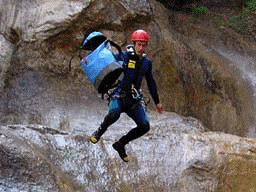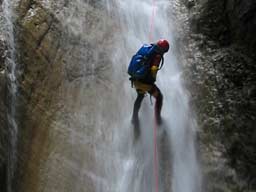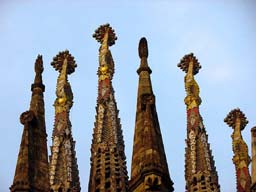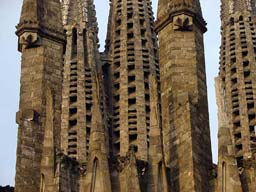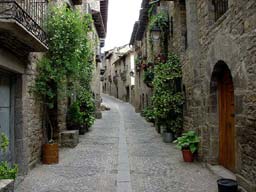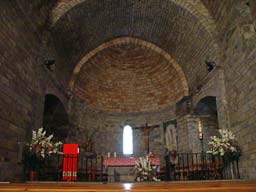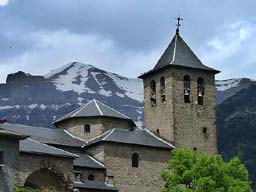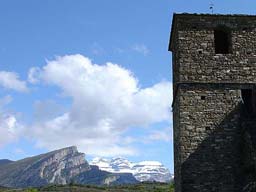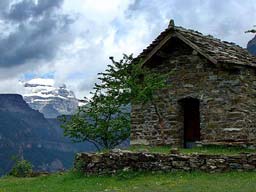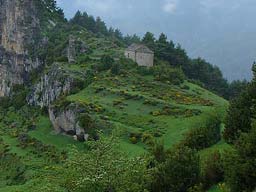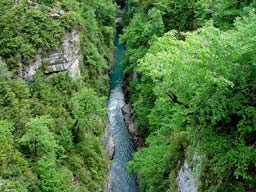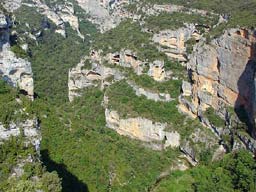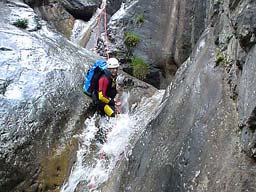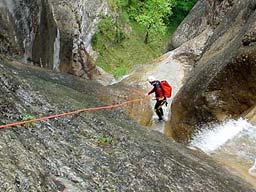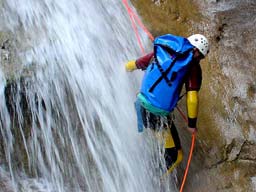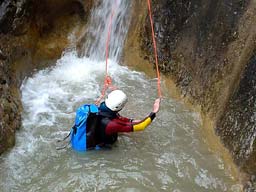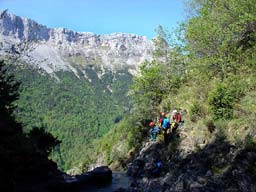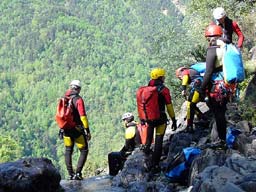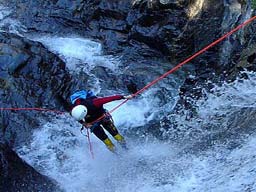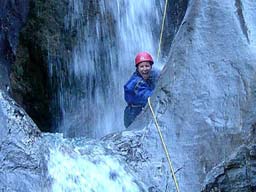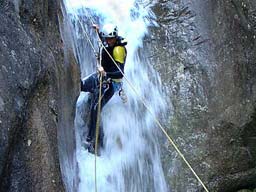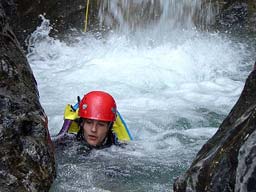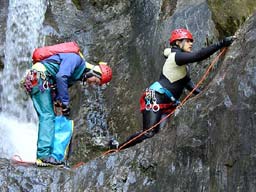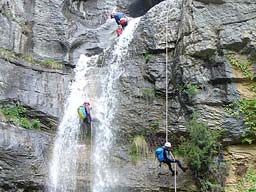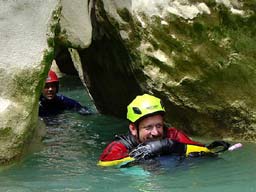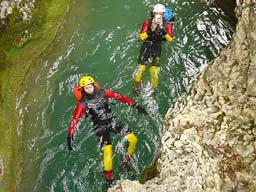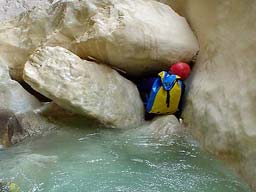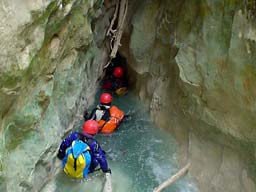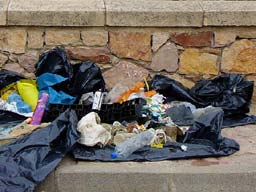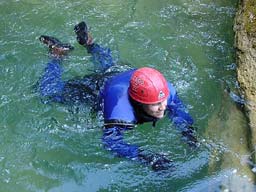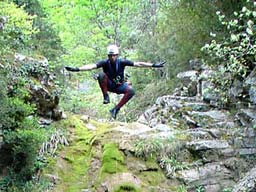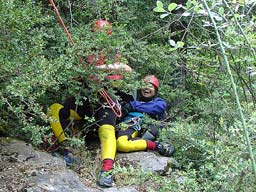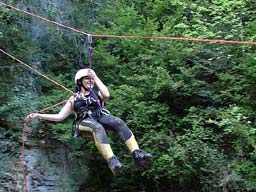|
INTRODUCTION
Part of the sport of canyoneering is exploring new places, new
types of canyons. Since I hadn't spent much time in limestone slots,
except for an ill-fated May 2003 trip to la Maglia in France where I had a little leg
problem, I was intrigued by the opportunity to travel to Spain to attend an
international rendezvous of canyoning enthusiasts. There was a chance to
see some diverse territory and experience an old and interesting culture.
THE SETTING
A quick tour of Barcelona was really appealing. It revived my college-day interests in modern art and introduced me to some things, like modernista
architecture, that are hard to appreciate other than in person. You could
imagine a plausible connection between the art and the convoluted and eroded
pinnacles to be found up north in Spanish canyon country. As you go up
into the mountains many well-preserved ancient villages are encountered, most of
which contain the ubiquitous houses of worship
dating from Roman (12'th century) and even earlier medieval times. Many
are located in spectacular natural
settings. The rendezvous was held in Ainsa, a small town of 11'th century
origins at the east end of a huge reservoir that drowned several other similar
villages upon its filling. Ainsa is right at the foot of the Pyrenees in a
fantastic valley.
Torla
The Pyrenees were cut by recent glaciations (from 1.6 million
years ago or so), leaving fractured peaks, U-shaped valleys, sharp knife edges,
and towering cirques that have not had time to erode (compared with the Rockies,
for example, which seem much smoother, though taller). Sedimentary
deposition and uplift generated a variety of rocks, and as a result we found several
rather different types of canyon in close proximity.
THE CANYONS
The canyons of the Pyrenees seem to be well known
and often visited. Good books, topos (beta), and access maps are readily available.
There are probably well over 200 descendable canyons (i.e. canyoning is prohibited in
the national parks) within a couple hours drive from Ainsa, the center for the
Rendezvous that was organized by Koen Viaene of pocolocoadventures.
A couple of helpful maps by Patrick Gimat show access
points and tabulate basic characteristics for canyons in the Monte Perdido and Sierra de Guara regions. The authors rate the canyons from 1
to 4 hearts ♥ ), as in how much do ya love'em?.
Difficulty ratings are 1 to 6, as in easy to extremely risky, engaging and/or
difficult. It seems that the canyons that rate a high 5 or a 6 have some
complicated rope work (like a relay), or a big (like > 50m) rappel. The
total drop in most of
the canyons is relatively small, however, perhaps a hundred meters of
thereabouts.
Most often the rappels will be short (except for one canyon with a 150m job that
ends up in a lake, so you could just jump....), but the main interest,
especially to me, was the incredibly beautiful the water.
In short, I have never seen prettier fresh water.
Clear, but tinted various shades of green and blue (or turquoise and cyan..etc).
Just spectacular. There is another symbol on the maps: the sort of
ubiquitous up arrow ( ↑ ), which indicates a serious
increase of difficulty with a significant rise in the water flow. Under such conditions
even a short rappel can become dangerous. More uniquely, many of these canyons
feature special sections where piles of huge boulders have fallen in to create
what are called regions of "CAOS", mazes where the
water is flowing (or crashing) through a pile of random blocs. You have to
pick your way through this matrix, usually by going under the boulders in the
water. But there are
siphons and dead-ends that you might have trouble getting out of. In some
circumstances it might be necessary to go over the top - which can become a
slow exercise in extreme bouldering. Anyway, even though it rained a lot,
we didn't encounter anything too nasty, though water flowing high and carrying
mud silt kinda turned us off from doing one of the classic canyons that I had
want to try, Gorgas Negras. Next time.
In the end we did 12 canyons in 9 days. Some
were full day affairs, others were short and interconnected. All were
quite different and incredibly fun. Below is a summary in chronological
order, with enough pictures, I hope, for you to get a feel for the place.
For the first four days we made pick-up groups at the rendezvous, usually
consisting of myself, Todd and Stephanie Martin, Dave Medding, and Denise
Manweiller, from the US, and several helpful and enthusiastic folks from Huesca
and other nearby towns.
TALE OF DAYS
1. Foz de Canal No map rating for this (I'd give it a ♥♥ / 3).
Nice canyon with one big 70m rap in the upper section (which would probably
warrant
it a 5+ or so difficulty rating from Mr. Gimat). However, when we arrived, suitably jet
lagged, it was raining like crazy, and thundering a small bit nearby. Not
to be deterred (well, put it that I was outvoted), we figured we could blast
through the lower ("inferior") section of 5 watery but easily managed raps
(i.e. no relays). It did seem that the water at the end of the canyon had
become considerably higher than it was when we started!
2. Consusa Inferior A classic ♥♥♥♥ / 5- with 20 rappels in or alongside
waterfalls. High up in the Pyrenees north of Lamiana. Really nice,
except that all groups seemed to converge on this one. Maybe 50 folks
playing down the slot. It got hectic when it started raining and there
were still a lot
of people stacked up in the canyon. We started doing tandem raps....
Awesome country to practice the art in.........
3. Rio Vero Another♥♥♥♥ / 3 you-gotto-love-it canyon. No rope needed, but
several mazes of Caos, with underwater passages and tunnels and overhangs.
Extremely pretty, both the walls and the water.
Koen Viaene, the organizer of the rendezvous at Ainsa, had arranged a
service project to pick up trash on our descent. We came out of Rio Vero with several
full garbage bags.
4. Barranco Arpio No map rating, but I'd give it ♥♥♥ / 3 ,
relative to the others we did.
Feeds into the big Aniselo canyon after starting near the beautiful little mountain hamlet
of Vio (see pix above). Pretty easy (about 12 raps, numerous downclimbs)
but very slippery (everyone assed out a few times). A chance to practice
some moves.....
A Neat Rendezvous. Many Folks Vowed to Return.
Go to Part 2 Go to Part 3
|

